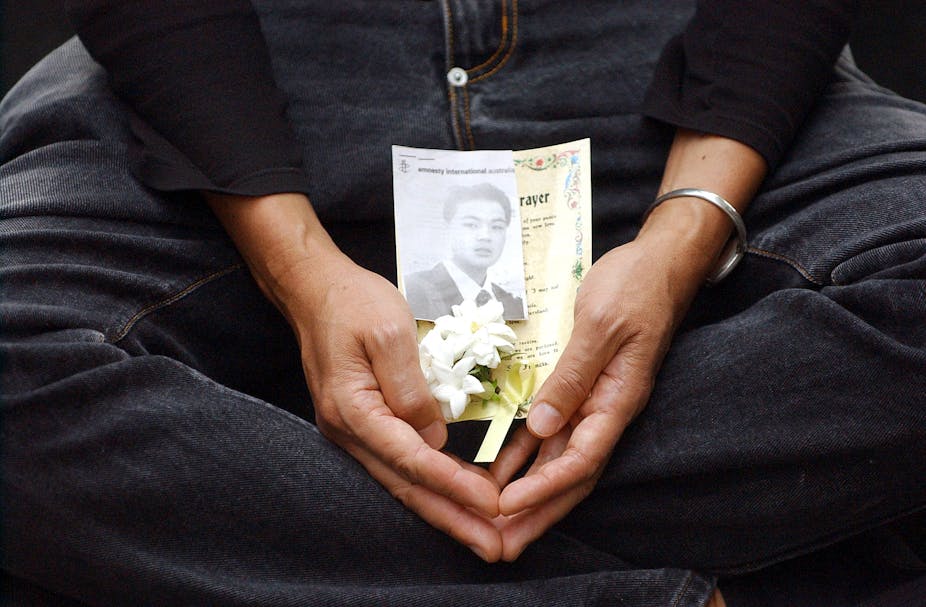In 2013, scholars David T. Johnson and Franklin E. Zimring characterised Asia as the “next frontier” in the global campaign to abolish the death penalty. While hard data on death penalty practices is notoriously difficult to find, there are indications of a Southeast Asian trend towards abolition.
The death penalty was abandoned in the Philippines in 2006, East Timor in 1999 and Cambodia in 1989. The last known executions in Laos and Myanmar were in 1989. Thailand has a high rate of clemency, which amounts to “de facto” abolition – its last reported execution was in 2009.
Bucking this alleged trend, Malaysia executed two people in 2013 and an average of one person per year between 2007 and 2011.
Indonesia resumed executions in 2013, ending a practical moratorium that began in 2008. Before that it executed between one and ten people annually. So far Indonesia has executed six people in 2015 and two Australians, Andrew Chan and Myuran Sukumaran, are being transferred on Wednesday to a prison island where they will be executed.
Vietnam allegedly executes about 100 people a year. Singapore hanged two people in 2014, none between 2010 and 2013, and at least one each year from 2007 to 2009.
Generalisations about the death penalty in Southeast Asia suggest abolitionist sentiments are increasing, yet practices vary substantially. To better understand the trends we must consider the context and political priorities of states that retain the death penalty. This is not to deny the significance of the death penalty reform movement, but to say that this activism must be understood in a local context.
The death penalty in Vietnam
In 2005, Vietnam reduced the offences to which the death penalty applies from 44 to 22. These reforms reportedly arose from an ambition to advance human rights.
The debate in Vietnam about changing sentencing principles is ongoing. Proposed changes include an exemption from the death penalty for people aged over 70; a qualification that the death penalty only apply in “particularly serious cases”; and the possibility of a suspended death penalty provision.
This last approach involves the court ordering the death penalty, but suspending its implementation pending proof of rehabilitation over a period of years.
Vietnam also briefly suspended executions by firing squad. This followed a government decision in late 2011 that execution should be more humane and be done by lethal injection.
Subsequently, the European Union imposed a ban on the export of a constituent chemical, Propofol, which resulted in a radical increase in the number of prisoners on death row and an impasse about whether to reinstate death by firing squad. In August 2013, executions by lethal injection began after ingredients were developed locally.
In effect, Vietnam is reformist and reductionist – but it is premature to classify it as abolitionist.
The death penalty in Singapore
Arguably, Singapore echoes a reductionist, rather than an abolitionist, trend.
Activists are seeking the abolition of the death penalty locally. In 2013 Singapore amended the Misuse of Drugs Act to remove the mandatory death penalty in drug cases. The act now allows for a life sentence and caning when an accused demonstrates that they were only a courier and that they provided “substantial assistance” to the authorities. The latter must be evidenced by a certificate from the Public Prosecutor.
Government figures claimed that the reform targeted increased co-operation with police. It did not reflect an abolitionist agenda. Others argue that global condemnation of the Singaporean government in 2005, when it executed young Australian drug mule Van Tuong Nguyen, contributed to the removal of the mandatory death penalty for some drug offences.
The next frontier?
If Asia is indeed the “next frontier”, what is the status of abolitionism today in Vietnam and Singapore? There are now live discussions about abolition throughout these countries, particularly among lawyers, and this is nurtured through pragmatic support. This is balanced by those advocating for its retention, particularly where drugs, terrorism or treason are involved.
However, when jurisdictions want to execute foreign citizens they must navigate particular perils. This is especially true when global media are galvanised against them.
Vietnamese practice suggests there has been differential treatment for some foreign nationals, made possible through the clemency process. Singapore rejects this approach, yet recent legal changes in Singapore offer “substantial assistance” as a means to avoid execution. Could this deliver the possibility of (foreigners) escaping the death penalty?
Current practices suggest Vietnam and Singapore demonstrate practical ways to reduce the incidence of the death penalty, particularly where foreigners are involved, rather than abolitionist tendencies. It is important to distinguish social and global media focus on the death penalty, which can either assist or hinder abolitionism, from policy changes.
At this stage, the death penalty remains in Singapore and Vietnam with little prospect of abolition. What we have seen are more humane approaches to execution (Vietnam) and reductionist reforms (both states). Over time, the prospect of foreign nationals escaping the death penalty seems likely to increase – although current experience in Indonesia exemplifies the danger of assuming this.

